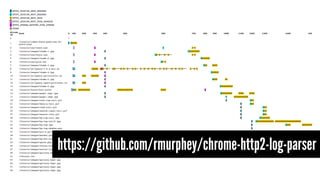Ad
The case for HTTP/2
- 1. http://www.flickr.com/photos/arnybo/2679622216 The Case for HTTP/2 @AndyDavies #GreeceJS, June 2016
- 3. 1999
- 4. 1999 RFC 2616 - HTTP/1.1
- 5. The Web of 1999…
- 6. …is not the Web of 2016
- 7. …is not the Web of 2016
- 8. http://www.flickr.com/photos/7671591@N08/1469828976 HTTP/1.x doesn’t use the network efficiently
- 9. and we’ve been hacking around some of the limitations https://www.flickr.com/photos/rocketnumber9/13695281
- 10. Each TCP connection only supports one request at a time* https://www.flickr.com/photos/39551170@N02/5621408218 *HTTP Pipelining is broken in practice
- 11. So browsers allowed us to make more requests in parallel Very old browsers - 2 parallel connections Today’s browsers - 4 plus connections
- 12. To make even more parallel requests we split resources across hosts www.bbc.co.uk static.bbci.co.uk news.bbcimg.co.uk node1.bbcimg.co.uk
- 13. Increasing the risk of network congestion and packet loss https://www.flickr.com/photos/dcmaster/4585119705
- 14. Every request has an overhead https://www.flickr.com/photos/tholub/9488778040
- 15. HTTP 1.x - Higher latency = slower load times PageLoadTime(s) 1 2 3 4 Round Trip Time (ms) 0 20 40 60 80 100 120 140 160 180 200 220 240 Mike Belshe - “More Bandwidth Doesn’t Matter (much)”
- 16. Accept:text/html,application/xhtml+xml,application/xml;q=0.9,image/webp,*/*;q=0.8 Accept-Encoding:gzip,deflate,sdch Accept-Language:en-US,en;q=0.8 Cache-Control:no-cache Cookie:NTABS=B5; BBC- UID=75620c7ca040deb7c0d3275d81c51c2361684a959e281319b3b5da4dab5958880Mozilla %2f5%2e0%20%28Macintosh%3b%20Intel%20Mac%20OS%20X%2010%5f9%5f1%29%20AppleWebKit %2f537%2e36%20%28KHTML%2c%20like%20Gecko%29%20Chrome%2f31%2e0%2e1650%2e63%20Safari %2f537%2e36; ckns_policy=111; BGUID=55b28cbc20d2e32f221f3ed0e1be9624c960f93b1e483329c3752a6d253efd40; s1=52CC023F3812005F; BBCCOMMENTSMODULESESSID=L-k22bbkde3jkqf928himljnlkl3; ckpf_ww_mobile_js=on; ckpf_mandolin=%22footer-promo%22%3A%7B%22segment%22%3Anull%2C%22end %22%3A%221392834182609%22%7D; _chartbeat2=ol0j0uq4hkq6pumu. 1389101635322.1392285654268.0111111111111111; _chartbeat_uuniq=1; ecos.dt=1392285758216 Host:www.bbc.co.uk Pragma:no-cache User-Agent:Mozilla/5.0 (Macintosh; Intel Mac OS X 10_9_1) AppleWebKit/537.36 (KHTML, like Gecko) Chrome/32.0.1700.107 Safari/537.36 Headers sent with every request Contain lots of repeated data and aren’t compressed
- 17. And small responses may not fill the TCP Congestion Window Could have sent more segments in this round-trip Small response
- 18. So we follow recipes e.g. Reduce Requests https://www.flickr.com/photos/nonny/116902484
- 19. Create CSS and JavaScript bundles ++++ = =
- 20. Create CSS and JavaScript bundles ++++ = =More to download and parse
- 21. Create CSS and JavaScript bundles ++++ = = x+ Whole bundle is invalidated if a single file changes More to download and parse
- 22. and combine images to make sprites
- 23. and combine images to make sprites To get just one sprite …
- 24. and combine images to make sprites Browser must download and decode the whole image To get just one sprite …
- 25. We override the browser’s priorities https://www.flickr.com/photos/skoupidiaris/5025176923
- 26. Embed binary* data using DataURIs url(data:image/ png;base64,iVBORw0KGgoAA AANSUhEUgAAABkAAAAZCAMAA ADzN3VRAAAAGXRFWHRTb2Z0d 2FyZQBBZG9iZSBJbWFnZVJlY WR5ccllPAAAAAZQTFRF/ wAAAAAAQaMSAwAAABJJREFUe NpiYBgFo2AwAIAAAwACigABt nCV2AAAAABJRU5ErkJggg==) = *dataURIs can be text too e.g. SVG
- 27. and inline ‘critical resources’ <!DOCTYPE html> <html xmlns="http://www.w3.org/1999/xhtml" xml:lang="en" lang="en-us"> <head> <meta http-equiv="content-type" content="text/html; charset=utf-8" /> <meta name="viewport" content="width=device-width, initial-scale=1.0" /> <link rel='stylesheet' href='http://fonts.googleapis.com/css?family=Open+Sans:400,300,600' typ <link rel="alternate" href="http://blog.yoav.ws/index.xml" type="application/rss+xml" title="Y <style> body { font-family: 'Open Sans', 'Helvetica Neue', Helvetica, sans-serif; color: rgb(72, 7 img { max-width: 100%; } .li-page-header { color: rgb(255, 255, 255); padding: 16px 0px; background-color: #8a1e1b; .container { position: relative; width: 90vw; max-width: 760px; margin: 0px auto; padding: .clearfix:before, .clearfix:after, .row:before, .row:after { content: '0020'; display: bl .row:after, .clearfix:after { clear: both; } .row, .clearfix { zoom: 1; }
- 28. There’s a tension between development and delivery https://www.flickr.com/photos/domiriel/7376397968
- 29. Build tools and optimisation services help plug gaps and won’t be going away…
- 30. But what if we could use the network more efficiently? https://www.flickr.com/photos/belsymington/4102783610
- 31. HTTP/2
- 34. HTTP/1.1 HTTP/2 https://http2.golang.org/gophertiles Impressive But is it a real world test?
- 35. • HTTP methods, status codes and semantics remain the same • Binary headers • Header compression • Multiplexed • Server can push resources HTTP/2
- 36. Each request becomes a stream
- 37. DATA frame HEADERS frame HTTP/1.1 200 OK Date: Mon, 07 Sep 2015 17:39:33 GMT Expires: -1 Cache-Control: private, max-age=0 Content-Type: text/html; charset=UTF-8 Content-Encoding: gzip X-XSS-Protection: 1; mode=block X-Frame-Options: SAMEORIGIN Transfer-Encoding: chunked <!doctype html> <html> <head> <meta charset="utf-8"> <title>This is my title<title> <link rel="stylesheet" href="styles.css" type="text/css" /> HTTP/2HTTP/1.1 Streams are divided into frames } } DATA frame DATA frame
- 38. Frames are multiplexed over a TCP connection … Stream 1 DATA Stream 2 HEADERS Stream 2 DATA Stream 1 DATA … Stream 4 DATA Client Server
- 39. TCP connection comparison HTTP/2 vs HTTP/1.1 HTTP/1.1 HTTP/2
- 40. Prioritised using Weights and Dependencies https://nghttp2.org/blog/2014/04/27/how-dependency-based-prioritization-works/ Weight: 200 id: 2 Weight: 100 id: 4 Weight: 1 id: 6 Weight: 100 id: 12 Weight: 100 id: 8 Weight: 100 id: 10
- 41. Prioritised using Weights and Dependencies https://nghttp2.org/blog/2014/04/27/how-dependency-based-prioritization-works/ Weight: 200 id: 2 Weight: 100 id: 4 Weight: 1 id: 6 Weight: 100 id: 12 Weight: 100 id: 8 Weight: 100 id: 10 2/3 1/3 Low priority
- 42. Prioritised using Weights and Dependencies https://nghttp2.org/blog/2014/04/27/how-dependency-based-prioritization-works/ Weight: 200 id: 2 Weight: 100 id: 4 Weight: 1 id: 6 Weight: 100 id: 12 Weight: 100 id: 8 Weight: 100 id: 10 2/3 1/3 Low priorityIn reality, there are some difficulties implementing this
- 43. What is the optimal order… Does it change as page loads? https://www.flickr.com/photos/add1sun/4993432274
- 44. Header compression https://http2.github.io/http2-spec/compression.html
- 45. Does it make any difference? Host: Ireland, Test Agent: Singapore, Cable
- 46. Does it make any difference? Host: Ireland, Test Agent: Singapore, Cable
- 47. Does it make any difference? Host: Ireland, Test Agent: Singapore, Cable
- 48. Does it make any difference? Host: Ireland, Test Agent: Singapore, Cable
- 49. What about when server and client are close? Host: Ireland, Test Agent: Ireland, Cable HTTP/1.1 HTTP/2
- 50. and evenly matched when server and client are close Host: Ireland, Test Agent: Ireland, Cable HTTP/1.1 HTTP/2
- 51. and evenly matched when server and client are close Host: Ireland, Test Agent: Ireland, Cable HTTP/1.1 HTTP/2
- 55. Opportunities for new kinds of optimisations https://www.flickr.com/photos/inucara/14981917985
- 56. Browser Server Server builds page GET index.html <html><head>… Network Idle Request other page resources Server push
- 57. Browser Server Server builds page GET index.html <html><head>… Request other page resources Push critical resources e.g. CSS Server push
- 58. Browser Server Server builds page GET index.html <html><head>… Request other page resources Push critical resources e.g. CSS Server push
- 59. Browser Server Server builds page GET index.html <html><head>… Request other page resources Push critical resources e.g. CSS Browser can reject push but may have already received data Server push
- 60. Many opportunities for server push HTML CSS DOM CSSOM Render Tree Layout PaintJavaScript Fonts and background images discovered when render tree builds Could we push them?
- 61. Multiplexing offers interesting possibilities too
- 62. How much of an image do we need to make it usable - 5%? Experiment by John Mellor at Google
- 63. Parallel version looks usable with just 15% of bytes
- 64. And almost complete with 25% of the image bytes!
- 65. There are some questions over the user experience with progressive images Sequential version needs 80% of bytes to match up…
- 66. When do we kill off some HTTP/1.1 optimisation techniques? http://www.flickr.com/photos/tonyjcase/7183556158
- 67. Browser support for HTTP/2 is relatively good 40 Edge 9b39 30a a. Opera Mini doesn’t support HTTP/2 b. Server-Push not supported yet
- 68. Server Support https://github.com/http2/http2-spec/wiki/Implementations Common servers already support it*
- 69. But choose your server carefully… Does it respect stream and connection flow? Does it support dependencies and weights? Does it support server-push? How does it help optimisation?
- 70. You might find some strange things… https://www.flickr.com/photos/joebenjamin/5009411920
- 71. Implementations are still young… Resources pushed in reverse order! (h20 v1.5.0 - fixed in h2o 1.5.3)
- 72. Different patterns of server resource usage http://engineering.khanacademy.org/posts/js-packaging-http2.htm
- 73. Sometimes browsers have unexpected behaviour… 1.6s 1.7s 1.8s 1.9s 2.0s 2.1s With Push 1.6 Without Push (Chrome 46, in Firefox both tests were fast)
- 74. with push without push 300ms gap in waterfall while Chrome’s preloader starts
- 75. Chrome recently deprecated NPN
- 77. Tools that might help you understand more https://www.flickr.com/photos/99783447@N07/9431062947
- 78. Wireshark
- 81. http://webpagetest.org Shows pushed resources in Chrome & Firefox tests
- 82. Balancing HTTP/1.1 & HTTP/2 https://www.flickr.com/photos/kyletaylor/589628071
- 83. Some good practices remain constant across HTTP/1.1 and HTTP/2 Shrinking content - compression, minification, image optimisation Reducing re-redirects Effective caching Reducing latency e.g. using a CDN Reducing DNS lookups and TCP connections
- 84. Others need to vary to make the most of each Replace inlining with server push Reduce CSS/JS concatenation and image spriting Avoiding sharding
- 85. HTTP/2 combines connections for shards When: Refer to same IP address Use same certificate (wildcard, or SAN) But… how well does this work in the field, with complexities of Global Load Balancing etc?
- 86. HTTP/2 combines connections for shards When: Refer to same IP address Use same certificate (wildcard, or SAN) DNS lookup, but no new TCP connection or TLS negotiation But… how well does this work in the field, with complexities of Global Load Balancing etc?
- 87. No content until DNS, TCP and TLS negotiation complete Efficient TLS is still important Session Resumption, Certificate Stapling and improvements in TLS v1.3 all help
- 88. Efficient TLS is Important istlsfastyet.com www.ssllabs.com/ssltestBulletproof SSL and TLS Ivan Ristic
- 89. https://www.flickr.com/photos/mariachily/3335708242 Still plenty of challenges…
- 90. Use of Third-Parties is still growing Requests by Domain Bytes by Domain
- 91. W3C Resource Hints should help <link rel="dns-prefetch" href=“//example.com”> <link rel="preconnect" href=“//example.com”> <link rel="preload" href=“//example.com/font.woff” as=“font”>
- 92. If you want to learn more… hpbn.co/http2 http://daniel.haxx.se/http2





















































































































































































